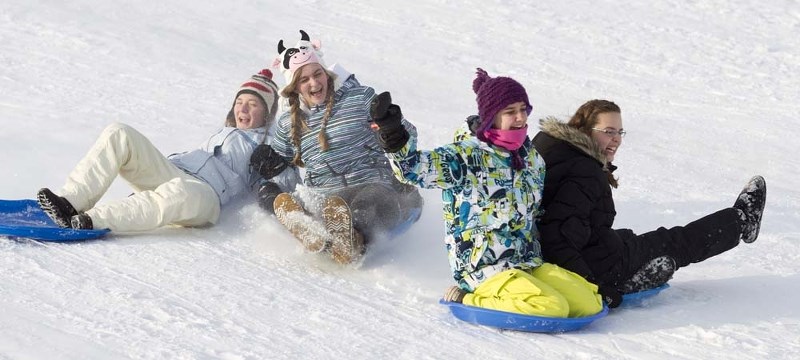It's likely that at one time or another most everyone in St. Albert has slid down Seven Hills, whether on a toboggan, a snowboard or even in a car, and it seems that pinning down the history of those seven hills is about as easy as climbing up the slippery slope in winter.
This hill, which is variously known as Church Hill and Mission Hill, probably only had seven terraces for about a decade – during the 1960s – but every generation has a tale to tell about the exploits that took place there.
An amateur GPS reading, shows the altitude in the parking lot above Seven Hills to be 650 metres above sea level. Down below, near the tennis courts, the altitude is 600 metres, so the hill boasts a vertical drop of approximately 50 metres. For comparison, consider the highest ski lift in the Rosa Khutor Ski Resort, site of the ski events at the 2014 Sochi Olympic Games. Known as the Caucasus Express Gondola, the lift stops at 2,320 metres. The vertical drop there is 1,760 metres.
If Seven Hills doesn't reach Olympian heights, it's high enough for those hiking up to the top without a ski lift. According to a local legend, it could be considered gigantic, says Steffanie Vaugeois, 26, who attended Father Jan School in the 1980s.
"When I was little, it didn't have seven hills. There were perhaps only three or four hills instead of seven and it wasn't bumpy," Vaugeois recalls. "One side of the hill was more gentle, for grades 1 to 3. The other bumpier side was for the bigger kids. But someone told me that a giant lived in town. The seven hills were his steps to get to the top of the hill."
Where are they?
But where exactly are the seven hills? From the parking lot level there is a dropoff, which makes one ledge, and there is another level area halfway down the hill, making the count two. If you were riding on a mountain bike or a toboggan, no doubt it would seem like there are many small bumps. But seven?
An Internet search shows there are dozens of cities in the world claiming to have seven hills, most famously Rome, which is sometimes called the City of Seven Hills. Perhaps the name is a mystical reference to that city, but for most of its last 150 years, St. Albert has had two hills, not seven.
The name Seven Hills likely stems from the 1960s when one of the many recontouring efforts took place. Father Lacombe and Bishop Tache would not have been counting to seven on that historic day in 1861 when they stopped above the hill for a pemmican lunch, because the terraces were not there yet.
"According to legend Father Lacombe and Bishop Tache stood near the chapel, approximately where the Father Lacombe statue is today. But even then there were no trees. They would have seen a gentle hill that went down to a slough behind the place where Father Jan school is located now," said Ray Pinco of the St. Albert Historical Society.
Pinco, who wrote a short history of Seven Hills for the Musée Héritage Museum, believes the first of the seven ledges developed when the old Youville Convent Home was built.
Pinco recalls playing on the "cliff portion" as a child in the early 1950s. Even then the cliff appeared different from the rest of the hill, he said.
"One portion was almost cliff-like and somewhat unstable. It was an engaging climbing challenge for young boys. I occasionally wondered about the steep slope. Quite a few years later, as an adult, former mayor Bill Veness knew the answer. When the four-storey brick section of the Youville Home was built in 1920, the dirt from the basement was simply dumped over the edge of the hill," Pinco said.
Various building endeavours – including the building of the Old Brick School, the Little White School and Father Jan school – altered the hill's character.
The six terraces were added after the demolition of the Old Brick School in 1960, the historian said.
"Children quickly and spontaneously coined the name Seven Hills. The name not only stuck, but soon became engrained into the community's vernacular," Pinco said.
Rough sledding
Sometime in the late 1960s the town council of the day asked John Beedle to level the more dangerous part of the hill.
"I was director of parks and the Seven Hills were too jarring for kids on a toboggan. Kids were hurting their backs. So I took out a 250-foot strip down the middle, which ended at the pond. The strange thing was, though we took out the middle to make it nice and smooth, the kids moved to the side where there were still terraces," Beedle said.
Since then, the terraces have been levelled again, but that doesn't stop the shenanigans on Seven Hills, which remain St. Albert's favourite playground.
Research from around town proved that Seven Hills was a testing ground for many youths. Often students in gym classes from St. Albert Catholic High School would run down the hill facing forward and then build strength by running backwards back up the hill.
Various anonymous people offered stories about reckless car driving attempts up the hill. Others talked about daring snowboarding and mountain bike challenges.
Seniors such as Pauline Vaugeois recall sliding down the hill on the darkest winter nights in the early 1950s without any lights to guide them.
"Who needed lights?" she asked, adding that often one of the kids would have a radio blaring to add to the fun.
"Maybe there was a streetlight by the church. Who cared?" she said. "We slid from almost in front of the church all the way down to the river. Oh boy! We could fly."




